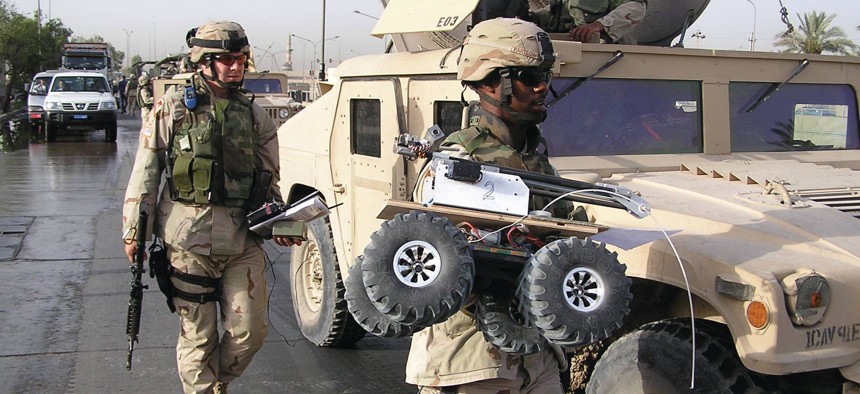
From the early days of the U.S. Army's Rapid Equipping Force: the 1st Cavalry Division sets out to deploy the Marcbot system in Iraq in 2004. U.S. Army / Sgt. Christina Rockhill
Don’t Learn the Wrong Lessons from Rapid Acquisition
Our enthusiasm must be tempered by an understanding of the wartime circumstances that made it work and the downsides that were accepted.
Every time the Marine Corps sent me back to Operation Iraqi Freedom, new and better equipment awaited: radios, armored vehicles, electronic jammers to foil roadside bombs. It was clear that the rapid acquisition policies created or updated for the Iraq and Afghanistan wars were sending high-performing, technical systems to the battlefield much faster than conventional acquisition could. They helped me do my infantryman’s job better, and helped our force adapt to evolving threats in months rather than years or decades.
Sensibly, policymakers are trying to figure out how rapid acquisition ideas could help the conventional acquisition system perform better. Early this year, the Pentagon enshrined rapid acquisition by including a dedicated section on it in the latest regulations governing acquisition. The Air Force recently announced that it is procuring its new B-21 bomber through its rapid capabilities office, and the Navy is setting up a similar office to speed up acquisitions.
Yet rapid acquisition practices that worked during recent wars may not easily translate to peacetime endeavors. Our enthusiasm must be tempered by an understanding of the circumstances that made it work and the downsides that were accepted in wartime.
In Iraq and Afghanistan, the Pentagon had a clear problem to solve: enemies were finding new ways to attack U.S. forces despite our advantages in size, technology and firepower. When Iraqi insurgents developed IEDs, for example, the U.S. altered its long-held vehicle plan and fielded the Mine Resistant Ambush Protected (MRAP) vehicle.
As well, the urgency of war allowed the lowering of institutional barriers to the process of developing and fielding equipment. Compared to conventional acquisition, there were fewer steps, more direct links to senior leaders who could greenlight promising ideas, and quicker evaluation by troops in the field. But this came at the cost of transparency and oversight. While conventional acquisition programs must notify Congress when money is put to a different purpose than originally intended, rapid acquisition programs are largely exempt. Lawmakers accepted this during Operations Iraqi Freedom and Enduring Freedom because there was a consensus that it was necessary to prevent more troops from being maimed and killed by IEDs on the dusty roads of Iraq and in the muddy canals of Afghanistan.
It was the right decision for the time, but associated accountability issues remain unaddressed. For example, what was then known as the Joint IED Defeat Organization was instrumental in addressing IEDs during Operation Iraqi Freedom and Enduring Freedom, but questions remain about how that agency was spending its budget. Those considering institutionalizing rapid acquisition more broadly should take note.
If the Pentagon is to reap the benefits of rapid acquisition for peacetime use, it must do three things.
First, keep existing rapid acquisition policies separate from its efforts to reform conventional acquisition, reserving them for wartime use. Encouragingly, the Pentagon’s latest acquisition regulation offers six tracks for different types of acquisition programs, each with streamlined lines of communication balanced against the risks expected in each program type. It should continue to refine those and not try to force a large program like the B-21 into the rapid acquisition track.
Second, come up with better means for testing effectiveness. Rapid acquisition programs had the “luxury” of being tested immediately in Iraq and Afghanistan. Conventional acquisition programs do not. If the Pentagon wants to reproduce the speedy results of rapid acquisition programs in peacetime, it must find more direct and efficient ways to determining effectiveness that involve the operational user earlier—and not penalize the contractor and the military for going back to the drawing board when something does not work.
Lastly, do not lose sight of the need for accountability in the pursuit of speed and effectiveness. Rapid acquisition programs have not been universally successful. Some programs were wasteful, others never got off the ground. Congress was very lenient at the time because of the urgency of the war, but this is not likely to be the case now that large-scale troop commitments in Iraq and Afghanistan have ended.
The Pentagon should be encouraged to learn from its rapid acquisition experience — and to avoid blind attempts to replicate wartime successes without fully understanding why they worked.



